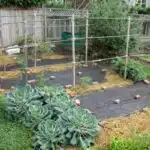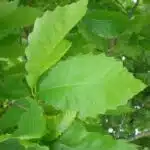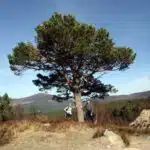As arborists, our primary task is to nurture and maintain healthy trees to ensure their longevity. However, sometimes we come across trees that have grown in a way that is not conducive to their health or the safety of those around them. One common issue is when a tree begins to lean, which can be due to various factors such as root damage or strong winds. In such situations, it becomes necessary for us to straighten and stake the leaning tree to prevent further damage and promote its proper growth.
Straightening and staking a leaning tree requires careful planning and execution to avoid causing additional harm to the tree or its surroundings. It involves assessing the extent of the lean, identifying the cause of the problem, determining the appropriate staking method, and monitoring the progress over time. In this article, we will discuss various techniques and tips on how to straighten and stake a leaning tree effectively. Whether you are a professional arborist or a homeowner looking to care for your trees, this guide will equip you with the knowledge required to ensure your trees continue thriving in good health for years to come.
Identifying The Problem
A leaning tree is a common problem that many arborists and tree care specialists encounter. For instance, take the case of a large oak tree growing on an incline. If the tree is not able to establish roots deep enough into the soil, it can start to lean in one direction. This can be caused by various factors such as soil erosion, root damage, or wind damage.
Prevention is key in avoiding a leaning tree. One of the most effective ways to prevent this issue is through proper planting techniques. When planting a new tree, it’s important to select an appropriate location based on soil type, sun exposure, and drainage conditions. Additionally, properly staking and supporting young trees can help them establish strong roots and prevent leaning in later years.
Inspecting the tree is crucial before attempting to straighten and stake it. An arborist must examine the extent of the lean and determine whether there are any underlying issues causing it. They will also assess the overall health of the tree to ensure that it can withstand being straightened without causing further damage. By thoroughly inspecting the tree beforehand, any necessary preparations can be made to ensure a successful straightening process.
Inspecting The Tree
Tree Inspection is an essential step in tree care and maintenance. Early intervention through inspection can prevent a leaning tree from becoming a hazard, causing property damage or posing a threat to the safety of people. Inspecting the tree involves assessing its overall health, identifying any damages or diseases present, and determining the extent of the lean.
Assessing the overall health of a tree is crucial in determining if it can be saved or if it needs to be removed. Arborists will inspect the branches, leaves, and bark for signs of damage or disease. If there are no visible signs of these issues, then the tree may have a chance at survival with corrective measures like staking.
Identifying damages or diseases present in the tree is equally important during inspection. Damages could be caused by weather events like storms or accidents that compromise the structural integrity of the tree. Diseases could affect the growth and stability of the tree over time, making it more susceptible to lean. An arborist will look for any signs of decay, rotting wood, or fungal growth on leaves or branches as indicators of disease.
Through Tree Inspection, early intervention can prevent further damage to a leaning tree before it becomes too late. In assessing the extent of the lean, arborists will determine whether staking alone can correct it or if other measures need to be taken like pruning branches that are too heavy on one side. By recognizing problems early on and taking appropriate action, trees can continue to thrive for years to come.
Assessing The Extent Of The Lean
After inspecting the tree, it is crucial to assess the extent of the lean before proceeding with any corrective measures. A leaning tree can be a hazard to both people and property, and it is important to determine how severe the problem is. Measuring angle is an effective way to quantify the degree of lean.
To measure the angle of lean, you will need a protractor or an inclinometer. The first step is to position yourself at a safe distance from the base of the tree and hold your measuring tool against the trunk at its highest point of inclination. Then, align your measuring tool so that it’s level with the ground, and read off the angle that’s indicated on it. Make sure that you take readings from several points along the length of the trunk as some trees may have multiple bends.
It’s worth noting that not all trees are equally susceptible to leaning, and different species have different tendencies towards this problem. For instance, conifers such as spruces and firs generally have shallower root systems than deciduous trees like oaks and maples, making them more vulnerable to toppling over in high winds or heavy snows. Additionally, young trees are more susceptible to leaning than mature ones because their roots haven’t had enough time to establish themselves fully in the soil. By taking into account these factors during assessment, you’ll be better equipped to determine what measures need to be taken for correcting a leaning tree.
Determining the cause of a leaning tree is essential for developing an effective remediation plan. In some cases, simple measures like staking or bracing may suffice for addressing minor leans caused by temporary factors like strong winds or storms; however, if there are underlying issues such as root rot or structural damage that require extensive repairs, then more complex solutions may be necessary. We will explore these options in greater detail in subsequent sections.
Determining The Cause Of The Problem
Determining the Cause of the Problem is crucial before proceeding with straightening and staking a leaning tree. There are various Causes of leaning trees, including environmental factors, disease, and pests. Environmental factors such as soil erosion or strong winds can cause a tree to lean over time. Disease can also affect a tree’s stability by weakening its roots and compromising its structural integrity.
Common tree diseases affecting stability include root rot, which is caused by fungal infection and affects the roots’ ability to anchor the tree in the soil. Another disease that affects trees is canker, which causes lesions on bark and branches that can weaken a tree’s overall structure. Pests such as termites or borers can also contribute to a leaning tree by burrowing into the trunk and weakening it from within.
To properly address a leaning tree, it is essential to identify the underlying cause of the problem. This will help determine the appropriate course of action for straightening and staking the tree effectively. Once you have identified what caused your tree to lean, you can move on to preparing it for straightening and staking without causing further damage or harm to your beloved plant life.
Preparing To Straighten And Stake
To successfully straighten and stake a leaning tree, proper preparation is key. This involves assessing the tree’s size and weight, as well as the soil quality and surrounding environment. As arborists and tree care specialists, we understand that saving a tree from potential collapse not only benefits the individual property owner but also contributes to the overall health of our urban forests.
One important aspect of preparation is determining the type of Tree Anchors needed for the specific tree. These anchors provide support by attaching to the trunk or root system and anchoring into the ground at a distance away from the base of the tree. The selection of Tree Anchors will depend on factors such as soil type, tree species, and site conditions. Choosing the correct anchor is crucial in providing adequate support while minimizing any potential damage to the tree.
Another essential component to consider when preparing to straighten a leaning tree is Soil Quality. Trees rely on healthy soil to receive nutrients, oxygen, and water necessary for growth. Before installing any stakes or anchors, it’s essential to assess soil quality to ensure that it can support both the weight of the anchor system and sustain long-term health of your trees. A thorough examination should be conducted by an arborist or soil specialist before proceeding with any installations.
Assessing Tree Anchors and Soil Quality are critical steps in preparing to straighten a leaning tree that cannot be overlooked. By selecting appropriate materials and ensuring strong soil structure, you’re taking proactive measures towards saving your trees from collapse while also contributing positively towards our urban forests’ overall health. In our next section on choosing the right materials, we’ll explore further how proper material selection can impact this process’s success rate.
Choosing The Right Materials
When it comes to straightening and staking a leaning tree, selecting appropriate tools are crucial. The tools you choose will depend on the size of the tree, the degree of lean, and the type of soil you are working with. For small trees, hand tools such as stakes, guy wires, and twine may be sufficient. However, for larger trees or those with severe lean, mechanical equipment such as winches or hydraulic jacks may be required.
Cost-effective options are also important to consider when choosing materials for straightening and staking a leaning tree. While high-quality materials can provide longer-lasting results, they can also come at a higher cost. Therefore, it is important to weigh the benefits and drawbacks of various materials before making a decision. For example, while metal stakes may be more durable than wooden ones, they can also cause damage to the tree if not installed correctly.
In addition to selecting appropriate tools and cost-effective options, considering the long-term health of the tree should also be a priority. Choosing materials that promote healthy growth and allow for proper airflow is essential in preventing future damage or disease. As an arborist/tree care specialist, it is our responsibility to not only address immediate concerns but also ensure that the tree remains healthy for years to come.
As we move forward in discussing staking techniques for straightening a leaning tree, it is important to keep in mind the selection of appropriate tools and cost-effective options we have discussed thus far. By prioritizing both short-term and long-term needs of the tree, we can ensure successful outcomes in our efforts to straighten and stake a leaning tree.
Staking Techniques
When it comes to caring for trees, nothing is more disheartening than seeing a tree that is leaning over. Whether it’s due to inclement weather or poor planting techniques, a leaning tree can be frustrating and potentially hazardous. Fortunately, there are staking techniques that can help straighten a leaning tree.
Different staking positions may be used depending on the severity of the lean and the size of the tree. One option is to use two stakes on opposite sides of the tree and attach them with flexible ties that allow for some movement. Another option is to use three stakes in a triangle formation around the base of the tree, which provides more stability but also limits flexibility. Ultimately, the staking position will depend on the specific circumstances of each individual tree.
While staking can be an effective way to straighten a leaning tree, it’s important to note that there are alternative methods as well. Some arborists may recommend pruning off any branches or foliage that are contributing to the imbalance of weight on the trunk. Others may suggest using guy wires instead of stakes to provide support without limiting flexibility. As always, it’s best to consult with a professional before attempting any corrective measures on your own.
Transition: Now that we’ve discussed different staking positions and alternatives, let’s explore some specific staking methods for different tree species.
Staking Methods For Different Tree Species
Staking Techniques are an essential aspect of tree care, especially for young trees with weak root systems or those planted in windy areas. As a tree care specialist, it is important to educate homeowners on the benefits of staking and how to avoid common mistakes that can harm the tree’s growth.
Benefits of staking include preventing the tree from leaning too far in one direction and promoting upright growth. It also helps prevent damage from wind or other weather events, which can be detrimental to young trees. However, it is important to note that staking should not be used as a long-term solution as it can negatively affect root development.
Common mistakes to avoid when staking a tree include tying the stake too tightly around the trunk, using inappropriate materials such as wire or rope that can damage the bark, and leaving the stake on for too long. Trees need movement to develop strong trunks and roots, so it is crucial to monitor progress over time and adjust stakes accordingly.
Transition: While staking techniques are essential in promoting healthy growth for young trees, different species may require specific methods for optimal results. In the next section, we will discuss staking methods tailored for different types of trees.
Monitoring Progress Over Time
To ensure the success of your tree straightening efforts, it is important to monitor progress over time. By tracking progress and documenting changes, you can analyze data to determine if any adjustments need to be made in order to achieve the desired outcome. This will also allow you to measure success and make any necessary modifications along the way.
One effective way to track progress is by measuring the angle of the tree’s lean over time. This can be done using a simple inclinometer tool or by taking measurements with a protractor at regular intervals. By keeping a record of these measurements, you can easily see if the tree is continuing to straighten or if it has reached a plateau. This information can then be used to make informed decisions about whether or not further action is needed.
In addition to monitoring changes in the angle of lean, it is also important to observe other indicators of progress such as new growth and overall stability. These factors can be recorded in a table, which allows for easy comparison over time. By analyzing this data, you can gain insight into how your tree is responding to your efforts and make any necessary adjustments accordingly.
Transition: Once you have tracked progress and analyzed data, it may become clear that adjustments need to be made in order for your tree straightening efforts to succeed. One potential adjustment involves adjusting the stakes that are supporting the tree, which we will discuss in the next section.
Adjusting The Stakes
After monitoring the progress of a leaning tree, it is essential to adjust the stakes as needed. Repositioning stakes involves moving them further away from the trunk of the tree to encourage root growth and avoid damage to the bark. This adjustment also allows for better air circulation around the base of the tree.
Adjusting tension in the stake system is equally important. As a tree grows, its diameter increases, and so should the distance between the stake and trunk. The tension on each stake must be checked regularly and adjusted accordingly to prevent rubbing or cutting into the bark. Over-tensioned stakes can cause structural problems for developing trees by creating a rigid support system that fails to promote strength.
A key factor to consider when adjusting stakes is timing. Leaving stakes on too long can create poor root development, leading to weaker trees in strong winds or heavy rain. A general rule of thumb is that stakes should be removed after one year or once a tree has developed enough anchoring roots to stand independently. In order to ensure optimal growth and stability, it is crucial to remove stakes at an appropriate time frame while closely monitoring any new developments in your tree’s health and structure.
Transition: Now that we have covered how repositioning and adjusting tension in stakes are vital for straightening a leaning tree, let’s focus on removing them without damaging your tree’s overall wellbeing.
Removing The Stakes
Stake removal is an important step in ensuring the stability of a previously leaning tree. Once a tree has been successfully straightened and staked, it is essential to remove the stakes in order to allow the tree to grow on its own. Typically, stakes should be left in place for no more than one year, as prolonged use can lead to damage or weakness in the trunk.
When removing the stakes, it is important to do so gradually rather than all at once. Trees that have been staked for an extended period of time may have grown dependent on their supports, and sudden removal can cause them to lean again or even topple over. Begin by loosening the ties around the trunk before gradually reducing the tension over several weeks. This will give the tree time to adjust and strengthen itself before being completely freed from its supports.
Once all stakes have been removed, monitor the tree closely for any signs of leaning or instability. It may be necessary to provide additional support if the tree shows any signs of weakness during this period of adjustment.
Transition: While stake removal is an important step toward promoting healthy growth and strength in a formerly leaning tree, there are also measures that can be taken to prevent future leaning altogether.
Preventing Future Leaning
Pruning techniques can be employed to reduce the amount of foliage and mass on the leaning tree, which will decrease its top-heaviness and lessen the likelihood of future leaning. Soil improvement can also be used to reduce future leaning of the tree by adding organic material to the root zone, which will increase the soil’s water-holding capacity and improve its stability. Additionally, strategically placed guy wires can be used to physically brace the tree against the direction of the lean, providing additional support and stability. Finally, the installation of root anchors can be used to secure the tree’s root system, helping to ensure that the tree has a stable footing and is not vulnerable to the effects of wind and other environmental factors.
Pruning Techniques
When it comes to preventing future leaning of a tree, pruning techniques can play a significant role in ensuring the stability and health of the tree. There are different types of pruning that arborists use to straighten a leaning tree, such as crown reduction, crown thinning, and crown raising. Crown reduction involves cutting back the branches on the top of the tree to reduce its overall height and weight. Crown thinning is where the inner branches of the canopy are removed to increase air circulation and allow more sunlight into the lower parts of the tree. Lastly, crown raising involves removing lower branches that may be interfering with pedestrian traffic or other objects.
The best time to prune a leaning tree depends on its species and location. Generally, it is recommended to prune during dormant seasons (winter or early spring) when there is less sap flow and fewer leaves on the tree. This timing can help reduce stress on the tree while also minimizing damage caused by insects or disease. However, some species like maples or birches should only be pruned in late summer or early fall when their sap is actively flowing.
In conclusion, pruning techniques are essential for preventing future leaning of trees. With various types of pruning available – such as crown reduction, crown thinning, and crown raising – arborists can tailor their approach according to each unique situation. Furthermore, choosing the right time to prune can also make a difference in how well a leaning tree responds to treatment. Ultimately, proper pruning can help maintain healthy growth patterns in trees while also improving their overall appearance and safety for those around them.
Soil Improvement
Preventing future leaning of trees is not only about pruning techniques, but also about improving the soil where the tree is planted. Soil improvement can help stabilize a tree’s root system and promote healthy growth. Composting techniques and fertilizer application are some of the ways arborists can improve soil conditions around a leaning tree.
Composting techniques involve adding organic matter to the soil, which can increase its nutrient content and improve its structure. Arborists often use composted leaves, grass clippings, or other organic materials to enrich the soil around trees. Fertilizer application is another way to improve soil conditions. By applying nutrients like nitrogen, phosphorus, and potassium directly to the soil, arborists can help stimulate root growth and enhance overall tree health.
Improving soil conditions is essential for preventing future leaning of trees. By promoting healthy root growth and providing proper nutrients, arborists can ensure that a tree’s root system remains stable and secure. Moreover, healthy roots are less susceptible to disease or insect infestations, which can weaken a tree’s structure over time. Thus, incorporating composting techniques and fertilizer application into regular maintenance practices can help keep trees healthy and upright for years to come.
Hiring A Professional Arborist
Hiring a professional arborist can be the most appropriate solution to straighten and stake a leaning tree. Although some people may prefer the DIY approach, it is important to consider the benefits of hiring an arborist. For instance, an arborist is trained in various techniques that help prevent further damage to your tree while ensuring proper staking and straightening.
While some homeowners may think that hiring an arborist is expensive, it could actually be cost-effective in the long run. Arborists use specialized equipment and techniques to ensure that your tree gets the care it deserves. Additionally, they can advise you on how to maintain your tree for future growth and health.
Moreover, hiring a professional arborist comes with additional benefits such as safety and insurance coverage. Arborists are trained on safety precautions during their work to avoid any unforeseen accidents or injuries. In case of any damage or injury during the work, an arborist’s insurance will cover any costs incurred.
In summary, when considering straightening and staking a leaning tree, hiring a professional arborist is worth considering due to its cost-effectiveness and numerous benefits such as safety precautions and insurance coverage. However, before hiring an arborist, ensure you research their qualifications and expertise to guarantee quality services. Next we’ll discuss some important safety precautions one should take when dealing with leaning trees.
Safety Precautions
- When straightening a leaning tree, it is important to consider the safety of both the tree and the person attempting to upright it.
- To ensure safety, the arborist should wear appropriate personal protective equipment, including gloves, hard hats, and safety glasses.
- The arborist should also maintain a safe distance from the tree during the straightening process to minimize the risk of injury.
- It is essential that the arborist wear heavy-duty gloves to protect their hands from bark and splinters.
- Additionally, eye protection must be worn to guard against flying debris and other hazards.
- Finally, to protect against potential injury from falling branches, a hard hat should always be worn by the arborist while attempting to upright a leaning tree.
Use Proper Safety Gear
Ensuring safety while straightening and staking a leaning tree is of utmost importance for both the arborist and anyone in the vicinity. It is crucial to wear proper safety gear, such as a hard hat, eye protection, gloves, and sturdy footwear. These types of protective equipment can prevent serious injuries in case of any accidents during the process.
The hard hat is essential for protecting the head from falling debris or branches that may come loose during the tree straightening process. Eye protection is important because it prevents dust or wood chips from getting into the eyes, which can cause irritation or even injury. Gloves provide a better grip on tools used to straighten and stake the tree while also protecting hands from splinters and cuts. Sturdy footwear reduces the risk of slipping or tripping on uneven ground or debris around the work area.
In conclusion, using proper safety gear plays an important role in ensuring a safe working environment for arborists while straightening and staking a leaning tree. The importance of wearing protective equipment cannot be overstated when dealing with hazardous situations involving trees. By using appropriate types of safety gear, arborists can minimize the risk of injury and ensure that they are able to serve those in need without compromising their own well-being.
Wear Eye Protection
Safety is a top priority when it comes to tree care, and arborists must take all necessary precautions to ensure that they are protected from any potential hazards. One of the most important safety measures that an arborist can take is wearing eye protection. Eye protection is crucial in preventing injuries caused by flying debris or wood chips during the tree straightening process.
Wearing eye protection when working with trees is essential because it reduces the risk of eye injuries. Arborists should always wear safety glasses or goggles that meet industry standards to protect their eyes from dust, wood chips, and other debris. Eye injuries can cause severe pain and even permanent vision loss, so it’s critical to take steps to prevent them.
In addition to protecting the eyes from flying debris during tree work, wearing eye protection can also help prevent eye strain due to glare from the sun or bright lights. This can be especially important when working on sunny days or near reflective surfaces like glass buildings or water. By taking the necessary safety measures, including wearing appropriate eye protection, arborists can ensure that they are able to provide safe and effective services while protecting themselves from harm.
Maintain A Safe Distance
As an arborist, maintaining a safe distance is another crucial safety measure that should be observed when working with trees. Trees are unpredictable, and accidents can happen without warning. Therefore, it’s essential to maintain a safe distance from the tree during tree work operations to avoid being injured by falling branches or debris. In addition, the arborist must assess the tree’s condition and determine the appropriate equipment needed for the job.
Maintaining a safe distance is especially important when working with large trees that require more effort and time to prune or remove. The arborist must ensure that they have enough space to maneuver around the tree while taking into account any obstacles in the surrounding area. Proper equipment like ropes, harnesses, and climbing gear must also be used to ensure safety and stability during pruning and removal procedures.
By maintaining a safe distance during tree work operations and using proper equipment, arborists can prevent potential accidents from happening. It’s always better to be prepared than sorry when it comes to safety measures in tree care services. Ultimately, prioritizing safety ensures that both arborists and customers benefit from quality services without any injuries or harm caused by negligence.
Conclusion
Safety is always a top priority when it comes to tree care. Before attempting to straighten and stake a leaning tree, arborists must assess the safety risks and take necessary precautions. This includes wearing appropriate personal protective equipment (PPE) such as hard hats, gloves, and safety glasses. It’s also important to secure the area around the tree and keep bystanders away during the process.
Common mistakes when trying to straighten a leaning tree include using inadequate stakes or ties that can damage the bark or restrict growth. Another mistake is not properly securing the roots, which can cause further damage to the tree’s stability. It’s also crucial to avoid over-correcting the lean of the tree, which could result in more harm than good.
Success stories in straightening a leaning tree involve careful planning and execution by experienced arborists. The proper method involves attaching strong stakes at an angle away from the lean of the tree and securing them with flexible ties that allow for some movement but prevent excessive swaying or bending. The roots of the tree should also be secured with deep anchors or bracing materials to ensure stability.
Overall, straightening and staking a leaning tree requires careful planning, execution, and attention to safety measures. Arborists who have experience in this process can provide successful results while avoiding common mistakes that may cause further damage to the tree’s health and stability. By following proper techniques and employing caution throughout the process, arborists can help trees remain upright and healthy for years to come.
Conclusion
As an arborist, it is imperative to ensure the safety and health of trees in our environment. Identifying a leaning tree is the first step in addressing the problem. Inspecting the tree and assessing its extent of lean will provide valuable information on how to proceed.
Determining the cause of the problem is crucial in formulating a solution. Preparing to straighten and stake the tree requires careful planning and execution. It is important to prevent future leaning by ensuring proper planting techniques and regular maintenance.
Safety precautions should always be taken when handling trees, as they can be unpredictable and dangerous. Hiring a professional arborist is highly recommended for complex jobs or inexperienced individuals.
As an arborist, we are stewards of nature and must take care of our natural resources for future generations. By following these steps, we can ensure the continued health and growth of trees in our communities. A straightened and staked tree not only represents stability but also symbolizes our commitment to environmental conservation. Let us all do our part in preserving this precious resource for generations to come.
Image Credits
- “Tree Lean” by cogdogblog (featured)





























